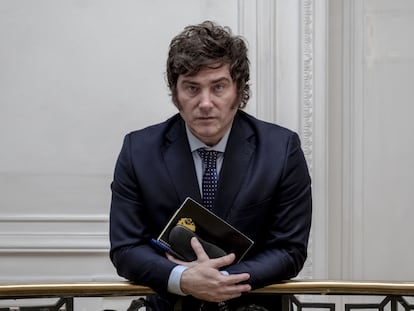Patricia Bullrich, Argentina’s iron lady
The presidential candidate, who was a left-wing guerilla in her youth, now represents the hard-line right in her primary battle. The polls are in her favor

With her fingers displaying the “V” for victory, a young Patricia Bullrich — today a candidate for the hard-right in Argentina — shows whoever is interested that she’s a Peronist. And not just any Peronist.
In 1983, when a camera captured an iconic shot of her as a young woman with curly black hair and an upward-turned gaze, Argentina was living in the twilight of the military dictatorship. Bullrich had just ended an exile that began in 1977 and that took her to Brazil, the United States and Mexico. Her militancy in Montoneros — the armed wing of revolutionary Peronism, the leftist ideology centered around Juan Domingo Perón, a soldier who ruled Argentina from 1946 until 1955 and 1973 until 1974 — had put her in the crosshairs of Jorge Rafael Videla’s regime (1976-1981). Bullrich was the sister-in-law of Rodolfo Galimberti, one of the heads of the organization. Under his command, she participated in a couple of failed attacks against the military government in Buenos Aires.
Forty years after that triumphant return, Bullrich is what is called a convert. Today, she represents the most recalcitrant right in Argentina. She hopes that her promise of a strong hand against crime and corruption — as well as her extreme anti-Peronism — will lead her to the Casa Rosada (the presidential palace) after the October 22 elections.
Bullrich also bears the surname Luro Pueyrredón. Her family roots go back to Argentina’s independence from Spain. Many streets, avenues, neighborhoods and squares throughout the country bear the last names of her ancestors. The most exclusive shopping center in the capital of Buenos Aires, for instance, is called Patio Bullrich. In the 1970s, it was common for young people from “good families” to be attracted to the Peronist banners of social justice. The most radical students joined the guerrilla movement against the military government. However, at the end of the day, these armed revolutionary organizations also had a militaristic element… one that Bullrich clearly shares.
Over time, the former minister of security (2015-2019) gradually abandoned her original revolutionary ideas. While she supports abortion rights and respects sexual diversity, these are about her only moderate positions. She completed her political metamorphosis during the center-right administration of Mauricio Macri, who lost his re-election in 2019. During her time in his cabinet, she often dressed up as a soldier, while her team flooded social media with videos of her attending drug seizures or overseeing arrests.
“The military dictatorship is going to end, it’s going to end,” chanted the young Argentines of the 1970s. Nearly half-a-century later, Bullrich says that “with me, this is over,” referring to the roadblocks set by protestors, public demonstrations, violent assaults and corruption. The keywords of her campaign are “strength,” “courage” and “change.” This message has a wide audience. The Argentine “decline,” she notes, is the fault of Peronism and, above all, of Néstor and Cristina Kirchner, the couple that governed the country from 2003 until 2015, divided into three left-wing administrations. Cristina Kirchner currently serves as vice president to left-wing incumbent Alberto Fernández.
Bullrich is calling for the reconstruction of the country, a process that will “destroy, dynamite and disarm the economy that Kirchnerism created.” The use of dynamite excites those who are fed up with the long-standing economic crisis. Bullrich warns there’s no longer room for “lukewarm” measures: only “going for everything” will make it possible to rebuild the lost order.
Now, the question is: who’s lukewarm? Well, according to Bullrich, it’s her rival in the primaries being held by the center-right Together for Change coalition: Horacio Rodríguez Larreta. The incumbent mayor of Buenos Aires feels more comfortable in the center — so far, he’s resisted the authoritarian drift of the main opposition alliance, founded by former president Macri. “I didn’t just shout about ‘getting rid of the drug dealers.’ I took them out, period,” he replies, when answering Bullrich’s allegations of being soft on crime.
Bullrich, 67, uses her life story as a political weapon to win over the electorate: “I was on the other side… I know very well what I’m talking about.” Kirchnerism, she says, has seized on the nostalgia of the young people from the 1970s. But this ideology has failed, it smells old, she emphasizes. Instead, she is offering order, progress and authority. Her political rhetoric weaves together the discourse of the traditional right and the extreme right.
If Bullrich wins her coalition’s primaries, one of her opponents will be Javier Milei, a neoliberal economist who has founded his own party. He’s promising to drastically reduce the size of the state and dollarize the economy. His voters are mostly young people, who are tired of what he refers to as the “political caste.” Bullrich is fighting to win some of those anti-establishment votes and her strategy of toughening her rhetoric appears to be working, as she’s steadily rising in the polls. Her base, however, lies in the conservative stream that runs through Latin America, which has led to the rise of figures such as the former Brazilian president Jair Bolsonaro, presidential candidate José Antonio Kast in Chile, or the popular and controversial incumbent Nayib Bukele in El Salvador.
Bullrich will compete with Larreta at the polls on August 13. If she wins her coalition’s presidential nomination in these primaries, she will face off in the October general elections against Milei and the Peronist candidate, Minister of Finance Sergio Massa. The polls show that Argentina’s iron lady is very close to taking power.
Sign up for our weekly newsletter to get more English-language news coverage from EL PAÍS USA Edition
Tu suscripción se está usando en otro dispositivo
¿Quieres añadir otro usuario a tu suscripción?
Si continúas leyendo en este dispositivo, no se podrá leer en el otro.
FlechaTu suscripción se está usando en otro dispositivo y solo puedes acceder a EL PAÍS desde un dispositivo a la vez.
Si quieres compartir tu cuenta, cambia tu suscripción a la modalidad Premium, así podrás añadir otro usuario. Cada uno accederá con su propia cuenta de email, lo que os permitirá personalizar vuestra experiencia en EL PAÍS.
¿Tienes una suscripción de empresa? Accede aquí para contratar más cuentas.
En el caso de no saber quién está usando tu cuenta, te recomendamos cambiar tu contraseña aquí.
Si decides continuar compartiendo tu cuenta, este mensaje se mostrará en tu dispositivo y en el de la otra persona que está usando tu cuenta de forma indefinida, afectando a tu experiencia de lectura. Puedes consultar aquí los términos y condiciones de la suscripción digital.
More information
Archived In
Últimas noticias
Welcome to the post-religion era: The idea of Christianity as the absolute truth has become obsolete
‘I thought you would like it’: The risky sexual practice popularized by TV shows and TikTok
The digitalization of tourism: ‘They promise experiences and gave us the worst possible one’
Mexican peso defies uncertainty with forecasts of a new period of stability in 2026
Most viewed
- Sinaloa Cartel war is taking its toll on Los Chapitos
- Reinhard Genzel, Nobel laureate in physics: ‘One-minute videos will never give you the truth’
- Oona Chaplin: ‘I told James Cameron that I was living in a treehouse and starting a permaculture project with a friend’
- Why the price of coffee has skyrocketed: from Brazilian plantations to specialty coffee houses
- Silver prices are going crazy: This is what’s fueling the rally











































